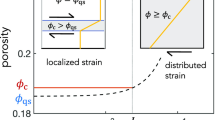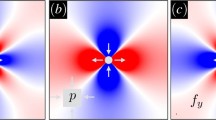Abstract
Many of the most important and commonly occurring, emergent geological structures such as shear bands, fault zones and folds may be understood as a consequence of changes in the type of the governing model equations. Such changes, or bifurcations, depend strongly on the details of the constitutive relationships including the presence of strain softening, thermal or chemical effects, and whether the flow rule is associated or non-associated, coaxial or non-coaxial. Here we focus on the influence of non-coaxiality of the flow rule on the development and evolution of shear bands. The term non-coaxial refers to the non-coincidence of the principal axes of the stress and of the plastic strain rate tensor. Non coaxial plasticity models were originally proposed by Josselin de Jong and A. J. M. Spencer. The geometric structure of most non-coaxial models is defined by the assumption that the plastic deformation is carried by one (single slip) or two (double slip) slip systems that are inclined at \({\pm (\pi /4+\nu /2), 0\leq \nu \leq \phi }\) to the less compressive principal stress axis; \({\phi }\) is the internal angle of friction of the material. Both cases –single and double slip– are considered here. A particular feature of the double slip model is the appearance of an additional variable requiring an additional constitutive relationship. Geometrically, the additional variable may be interpreted as a spin. Spencer assumed that, in 2D, the additional spin is equal to the rate of rotation of the principal axes of the stress tensor. Here we show that Spencer’s assumption is very similar (up to a factor of proportionality) to the assumption that the internal slip systems are material. We also propose an alternative closure, based on experimental observations, indicating that the ratio between the average particle spin and the spin of a spatial element of the granular assembly is constant, in simple shear. Finally, we propose a closure for the double slip model within the framework of a Cosserat Continuum theory. In a Cosserat continuum, a material point possesses the degrees of freedom of an infinitesimal rigid body: three translations and three rotations. In this case the indeterminacy of the double slip model is removed by the angular momentum balance equation associated with the rotational degrees of freedom. We propose constitutive relationships for the Cosserat model and illustrate the behavior of the model by means of an analytical solution of the simple shear problem.
Similar content being viewed by others
References
Anand L.: Plane deformations of ideal granular materials. J. Mech. Phys. Solids 31(2), 105–122 (1983)
Biot M.A.: The Mechanics of Incremental Deformations. Wiley, New York, London, Sydney (1965)
Bardet J.P., Vardoulakis I.: The asymmetry of stress in granular materials. Int. J. Solids Struct. 38(2), 353–367 (2001)
Buck W.R.: Models of continental lithosphere extension. J. Geophys. Res. 96(B12), 20161–20178 (1991)
Chen W.F.: Limit Analysis and Soil Plasticity. Elsevier, Amsterdam (1975)
Tordesillas, A., Shi, J., Muhlhaus, H.B.: Non-coaxiality and force chain evolution. Int. J. Eng. Sci. (2009). doi:10.1016/j.ijengsci.2008.12.011
De Josselin de Jong G.: The undefiniteness in kinematics for frictionmaterials. Proc. Conf. Earth Press. Probl., Brussels 1, 55–70 (1958)
De Josselin de Jong G.: The double sliding, free rotating model for granular assemblies. Geotechnique 21(3), 155–162 (1971)
England P.: Constraints on extension of continental lithosphere. J. Geophys. Res. 88(B2), 1145–1152 (1983)
Eringen A.C.: Polar and non local field theories. In: Eringen, A.C. (eds) Continuum Physics, Academic Press, UK (1976)
Fleck N.A., Hutchinson J.W.: Strain gradient plasticity. Adv. Appl. Math. 33, 295 (1997)
Gibbs A.D.: Structural evolution of extensional basin margins. J. Geol. Soc. 141(4), 609–620 (1984). doi:10.1144/gsjgs.141.4.0609
Gross L., Bourgouin L., Hale A.J., Mühlhaus H.-B.: Interface modeling in incompressible media using level sets in Escript. Phys. Earth Planet. Inter. 163(1–4), 23–34 (2007)
Harris D.: A unified formulation for plasticity models of granular and other materials. Proc. R. Soc. Lond. A 450, 37–49 (1995)
Hill R., Hutchinson J.W.: Bifurcation phenomena in the plane strain tension test. J. Mech. Phys. Solids 23, 239–264 (1975)
Hill R.: The Mathematical Theory of Plasticity. Oxford University Press, Oxford (1998)
Lubliner J.: Plasticity Theory. Macmillan Publishing, New York (1990)
Jiang M.J., Harris D., Yu H.S.: Kinematic models for non-coaxial granular materials, Part I. Int. J. Numer. Anal. Meth. Geomech 29, 643–661 (2005)
Jiang M.J.D., Harris D., Yu H.S.: Kinematic models for non-coaxial granular materials, Part II. Int. J. Numer. Anal. Meth. Geomech 29, 663–689 (2005)
Lemiale V., Muhlhaus H.-B., Moresi L., Stafford J.: Phys. Earth Planet. Inter. 171(1–4), 177–186 (2008)
Mehrabadi M.M.S.C., Cowin S.C.: On the double sliding free rotating model for the deformation of granular materials. J. Mech. Phys. Solids 29(4), 269–282 (1981)
Kroener, E.: Mechanics of generalized continua. In: Proceedings of the IUTAM-Symposium on the Generalized Cosserat Continuum and the Continuum Theory of Dislocations with Applications. Springer, Freudenstadt, Stuttgart (1967)
Matsuoka H.: A microscopic study on shear mechanism of granular materials. Soils Found 14, 29–43 (1974)
Moresi L., Mühlhaus H.-B.: Anisotropic viscous models of large-deformation Mohr-Coulomb failure. Philos. Mag. 86, 3287–3305 (2006)
Mühlhaus H.-B., Vardoulakis I.: The thickness of shear bands in granular materials. Geotechnique 37, 271–283 (1987)
Mühlhaus H.-B.: Application of cosserat theory in numerical solutions of limit load problems. Ing. Arch. 59, 124–137 (1989)
Mühlhaus H.-B.: Stress and couple stress in a layered half plane with bending stiffness. Int. J. Numer. Anal. Meth. Geomechanics 14, 545–563 (1990)
Mühlhaus, H.-B.: Continuum models for layered and blocky rock. Comprehensive Rock Engineering. Invited Chapter for Vol. II: Analysis and Design Methods, pp. 209–230. Pergamon Press (1993)
Mühlhaus H.-B., Dufour F., Moresi L., Hobbs B.E.: A director theory for viscoelastic folding instabilities in multilayered rock. Int. J. Solids Struct. 39, 3675–3691 (2002)
Ochiai H., Yamanouchi T., Tanabashi Y.: On the rotation of principal stress axes in simpleshear and its utilizations. In: Shahinpoor, M. (eds) Advances in the Mechanics and the Flow of Granular Materials, pp. 871–883. Trans Tech Publications, USA (1983)
Pasternak E., Muhlhaus H.-B.: Generalized homogenization procedure for granular materials. J. Eng. Math. 52, 199–229 (2005)
Roscoe K.H.: An apparatus for the application of simple shear to soil samples. Proc. 3rd Int. Conf. Soil Mech. Found. Eng. Zuerich 1, 186–191 (1953)
Roscoe K.H., Bassett R.H., Cole E.R.: Principal axes observed during simple shear of asand. Proc. Geotech. Conf., Oslo 1, 231–237 (1967)
Roscoe K.H.: The influence of strains in soil mechanics. Geotechnique 20, 129–170 (1970)
Rudnicki J.W., Rice J.R.: Conditions for the localization of deformation in pressure sensitive dilatant materials. J. Mech. Phys. Solids 23, 337–351 (1975)
Salencon J.: Application of the Theory of Plasticity in Soil Mechanics Ed. Wiley, New York (1977)
Spencer A.J.M.: A theory of the kinematics of ideal soils under plane strain conditions. J. Mech. Phys. Solids 12, 337–351 (1964)
Spencer A.J.M.: Deformation of Ideal Granular Materials, Mechanicsof Solids: The Rodney Hill Anniversary Volume, pp. 607–652. Pergamon Press, Oxford (1982)
Thornton C., Zhang L.: A numerical examination of shear banding and simple shear non-coaxial flow rules. Philos. Mag. 86, 3425–3452 (2006)
Tvergaard V., Needleman A., Lo K.K.: Flow localization in the plane strain tensile test. J. Mech. Phys. Solids 29(2), 115–142 (1981)
Vardoulakis I., Sulem J.: Bifurcation Analysis in Geomechanics. Chapman and Hall, London (1995)
Vermeer P.A., de Borst R.: Non associated plasticity for soils, concrete and rock. Heron 29, 1–62 (1984)
Walsh J., Watterson J., Yielding G.: The importance of small-scale faulting in regional extension. Nature 351, 391–393 (1991)
Watts A.B., Bodine J.H., Steckler M.S.: Observation of flexure and the state of stress in the oceanic lithosphere. J. Geophys. Res. 85, 6369–6376 (1980)
Zbib H.M.: On the mechanics of large inelastic deformations:non-coaxiality, axial effects in torsion and localization. Acta Mechanica 87, 179–196 (1991)
Author information
Authors and Affiliations
Corresponding author
Rights and permissions
About this article
Cite this article
Muhlhaus, H., Moresi, L., Gross, L. et al. The influence of non-coaxiality on shear banding in viscous-plastic materials. Granular Matter 12, 229–238 (2010). https://doi.org/10.1007/s10035-010-0176-9
Received:
Published:
Issue Date:
DOI: https://doi.org/10.1007/s10035-010-0176-9




